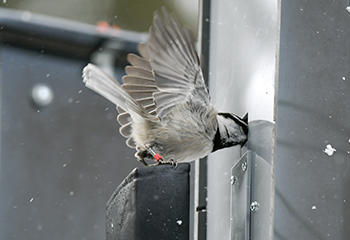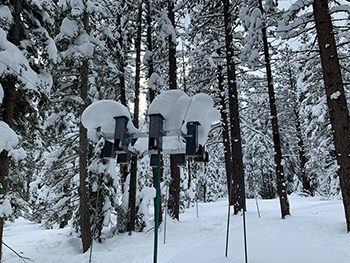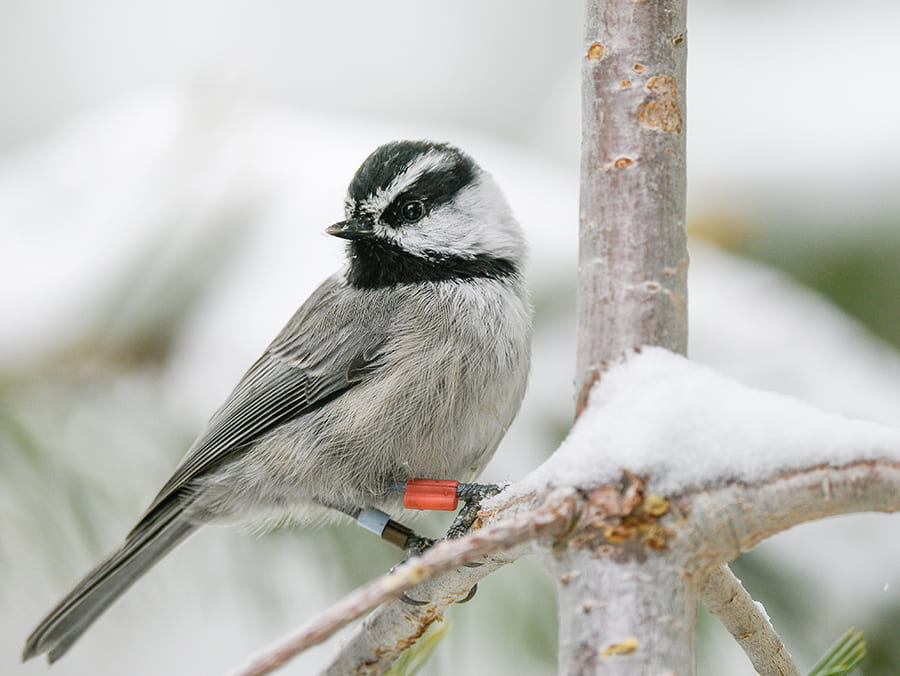In a long-term study of mountain chickadees, researchers have shown for the first time that there is a genetic component linked to the tiny birds' highly specialized spatial memory and that differences in memory abilities among birds were associated with genetic differences.
"Our recent research on wild, free-living mountain chickadees in the northern Sierra Nevada mountains provides the first direct evidence for natural selection via differential survival based on spatial learning and memory abilities," Vladimir Pravosudov, a senior author of the study and professor in the Department of Biology at the University of Nevada, Reno, said. "Comparing the genomes of these birds – ranging from best to worst in their performance on a spatial cognitive task – revealed significant associations with genes involved in neuron growth and development and hippocampal function.
Mountain chickadees are non-migratory food-caching birds that rely on specialized spatial memory to recover tens of thousands of stored food items scattered throughout their territories in the harsh Sierra winters. Individuals with better spatial learning and memory abilities are more likely to survive their first winter compared to those with worse spatial cognition.
To test spatial memory, Pravosudov and his team built sophisticated Radio Frequency Identification-equipped feeders where mountain chickadees banded with unique Passive Integrated Transponder (PIT) tags had to find the one feeder out of an array of eight that would give them a seed.

The feeder sensor reads the bird's ID tag and if it's the matching feeder for that individual, a mechanism opens the door, and the bird gets a seed. Co-author Eli Bridge from University of Oklahoma's Ecology and Evolutionary Biology program led the design and building of the RFID system.
The scientists then tracked how well birds learned and remembered their assigned feeder by measuring ‘errors’ or the number of unrewarding feeders each bird visited prior to visiting the correct feeder over multiple trials.
"This is an effective system to test spatial learning and memory in hundreds of wild chickadees in their natural environment," Pravosudov said. "We have previously shown that even very small variations in performance are associated with differences in survival."
Genomes of chickadees with different spatial learning and memory performance were then analyzed in Scott Taylor’s lab at the University of Colorado Boulder. Birds that did better at the task showed differences in their genomes when compared to genomes from birds who did less well.
"We found significant differences in numerous genes associated with individual variation in spatial learning and memory ability in the food-caching mountain chickadees," Pravosudov said. “What is especially interesting is genetic differences we detected were associated with genes involved in development and function of the hippocampus, a brain region involved in spatial memory. These study results identify candidate genes associated with differences in spatial cognition and provide a critical link connecting individual variation in spatial cognition with natural selection."
In other words, an individual bird’s genes appear to lay the cognitive foundation upon which that individual may then build via learning and experience. This suggests that the chickadee spatial cognition may be determined, at least in part, early in development, and that it's not just learned behavior.
"Environment does still matter a lot in terms of shaping behavior, but our work here suggests that genes may create the brain structures, and then experience and learning can build on top of that," Carrie Branch, the lead author and research postdoctoral fellow at the Cornell Lab of Ornithology, said.
Pravosudov’s is currently the only lab in the world that carries out systematic study of spatial learning and memory in wild food-caching birds in extreme environmental conditions.

"This paper emerged from Professor Pravosudov’s development of the mountain chickadee study system – one of the most important, perhaps the singularly most important system in the world, for studying animal cognition in the wild," Jack Hayes, chair of the Department of Biology said. "The paper makes an exciting link between phenotypic and genomic variation in the wild."
The team sampled 42 mountain chickadees across three years of testing ranging from the best to the worst in their performance on a spatial learning and memory task. The group with better spatial cognition was associated with a significant survival advantage. Birds from both high and low elevations were selected for each performance group to ensure that the strongest signal between groups was variation in cognition and not a correlate of elevation.
To understand the connection between spatial memory and genetic architecture, Georgy Semenov and Scott Taylor (also a senior author on the paper) at the University of Colorado-Boulder sequenced and analyzed genomes of mountain chickadees that varied in their cognitive performance.
"We used two methods to link genetic variation with spatial memory in chickadees," Semenov said. "In the traditional genome-wide approach, we compared genetic data across individuals, from those that performed well on the spatial learning and memory task to those that performed poorly. We did the same comparison with a new machine learning algorithm.
"Both methods showed hundreds of differences associated with spatial memory. Many of the variations in the genomes turned up in areas known to be associated with learning, memory, and neuron development in the brain."

In addition to Carrie Branch, Vladimir Pravosudov, Scott Taylor, Georgy Semenov and Eli Bridge, other co-authors on the paper included Dominique Wagner from the University of Colorado Boulder as well as Benjamin Sonnenberg and Angela Pitera who are doctoral students in Pravosudov’s lab in the Ecology, Evolution and Conservation Biology Graduate Program at the University of Nevada Reno.
The findings were published in the journal Current Biology Nov. 3. The research is a collaboration with the University of Nevada, Reno, the University of Colorado Boulder, the Cornell Lab of Ornithology and the University of Oklahoma.
Pravosudov is a Fellow of the Animal Behavior Society and a Fellow of the American Ornithological Society.
This research was supported by the National Science Foundation with two grants to the University of Nevada, Reno (Vladimir Pravosudov) and to the University of Colorado Boulder (Scott Taylor); and by a Rose Postdoctoral Fellowship from the Cornell Lab of Ornithology (Carrie Branch).
All photographs accompanying this article were taken by Vladimir Pravosudov.















